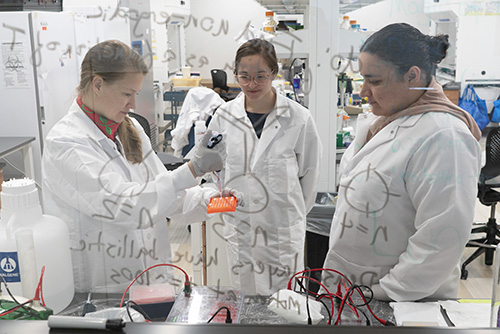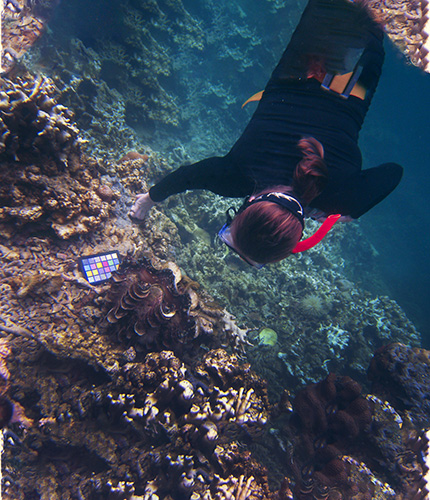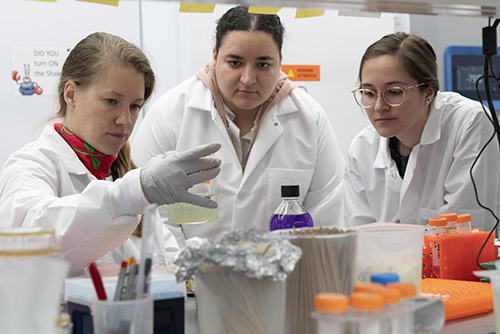Mentoring Matters
Story by Matt Wing
Influential professors fostered the freedom to explore unexpected interests for Alison Sweeney ’01, who now does the same for her students at Yale University.
Alison Sweeney ’01 arrived on Illinois Wesleyan’s campus in the Fall of 1997 knowing one thing for certain: she wanted to do a lot of things.
The two-hour drive down Interstate 39 from her hometown of Rockford, Illinois, gave Sweeney one last opportunity to make a mental checklist of all the endeavors she planned to undertake as an eager college freshman.
“I had a lot of interests in high school that I wanted to keep pursuing,” she explained.
Sweeney ultimately chose IWU for the freedom to do just that. Some gentle coaxing from her parents, alums Dennis ’73 and Sue (Peters) Sweeney ’75, didn’t hurt. But passions for biology and Russian language and playing the trumpet — and the desire to delve into previously unexplored areas — guided her decision more than anything else.
“I was really excited about the opportunities at Wesleyan to pursue a lot of interests with some seriousness all at once,” she said.
Sweeney found what she was looking for at IWU and, thanks to mentoring from dedicated faculty members, her eyes were opened to new interests and fascinating areas of study.
Gabe Spalding, B. Charles and Joyce Eichhorn Ames Professor of Physics, proved to be an important ally for Sweeney. When a burgeoning interest in physics sometimes felt at odds with a declared biology major (Sweeney was a double major in both biology and Russian), Spalding offered encouragement and advice on how to combine her interests. “I remember having some really good conversations with him,” she said.
Marina Balina, recently retired Isaac Funk Professor of German and Russian, helped Sweeney land a spot in IWU’s study abroad program that sent Sweeney to Bratislava, Slovakia, for a semester. “I couldn’t have done that without Dr. Balina’s support,” Sweeney said.
Biology professors Will Jaeckle, Loni Walker and the late Susie Balser also played important roles during Sweeney’s time at IWU.
And an experience gained between her sophomore and junior years at IWU provided a breakthrough moment for Sweeney.

Encouraged by Balser, her research adviser at IWU, Sweeney applied for the National Science Foundation’s Research Experiences for Undergraduates program and was selected for a summer internship at Stony Brook University. The program offered Sweeney the opportunity to research at a top-flight institution, alongside a distinguished professor sharing her research interest in invertebrate physiology.
She was greeted with some bad news, however, upon her arrival that summer at Stony Brook.
“My intended mentor had gone to Sweden for research and they had to scrounge up somebody else for me,” Sweeney recalled. “The guy was a biogeochemist and, at first, I was like, ‘What am I going to do? This is a disaster! I don’t know anything about biogeochemistry!’”
But Sweeney found her new mentor, Sergio Sanudo-Wilhelmy, to be supportive and insightful, much like the faculty members she studied under at Illinois Wesleyan. Her passion for research was reinforced. Perhaps most importantly, the experience proved to be an empowering one for Sweeney, who maneuvered an unexpected shift in the focus of her research without blinking.
“Although it wasn’t anything like what I thought I was going to be doing, I had a real knack and love for the process of research in and of itself,” Sweeney said. “It ended up being a great experience, being thrown into this thing that I wasn’t initially interested in, and I found that the process of asking and answering a question through experiments and data was really exciting and satisfying.”
Sweeney finished her time at Illinois Wesleyan with a bachelor’s degree two years later. She graduated magna cum laude and with research honors for her study, “Morphology and Vascular Physiology of the Segmented Marine Worm, Glycera dibranchiata .” A Presidential Scholar and a charter member of IWU’s chapter of Phi Beta Kappa, Sweeney left IWU ready for the next chapter of her story.
Sweeney credits her IWU experience for helping her navigate a rigorous Ph.D. program at
Duke University and six years of postdoctoral work at the University of California, Santa Barbara. Research interests born at IWU blossomed in those settings. At Duke, she pursued a doctorate in biology, even while her academic interest veered toward physics (once again, Spalding provided guidance). At UCSB, she published her first major research findings, detailing the biophysical mechanisms that underpin squid camouflage.
“I don’t know if students at some of those research schools receive as strong a grounding in the fundamentals in the field. I think that is what Illinois Wesleyan really offered me, and I think that’s really served me well in having a strong foundation to work from and being able to be flexible and creative,” Sweeney said. “I started off as a generalist, rather than a specialist, leaving undergrad.”
Sweeney earned a multitude of awards and grants and fellowships during her time at Duke and UCSB, all of which helped her eventually land her first professorship, at the University of Pennsylvania, in 2012 (a recommendation from Spalding, who put in a good word with Penn faculty members, only strengthened her candidacy).
The new role allowed Sweeney not only to lead a research group for the first time in her career, but to build it from the ground up, selecting undergraduate, graduate and postgraduate students to fill out the team’s roster. The group studied the evolution of novel materials in nature, which provided an umbrella wide enough to cover Sweeney’s many areas of interest. Studies included the self-assembly of squid eye lenses, giant clams’ ability to turn sunlight into fuel, and the mechanism behind the dazzling array of shapes found in grains of pollen.
Sweeney is, and has always been, fascinated by the simple solutions nature employs to thrive in a complex world; she’s prone to phrases like “nature finds a way” and “nature figures it out.”
Whether it’s self-assembly of squid lenses (which she compares to throwing a set of loose Legos in a paper bag, shaking it, and opening it to find a fully-assembled Lego castle) or the way iridocytes and microalgae cells align in giant clams to concentrate sunlight in what can fairly be described as a natural solar panel, Sweeney constantly marvels at processes in nature that not even the world’s leading engineers can replicate.
But Sweeney isn’t the only one who wonders what if …

There’s growing interest within the scientific community to determine if nature’s solutions, perfected by evolution, can be used as blueprints for 21st century products and processes. Sweeney attended a conference in Switzerland last year focused on “biomaterials,” “bioinspiration” and “biomimicry” — all trending topics in the field.
“This notion that biology knows how to do really sophisticated things with really simple building blocks is a popular idea,” Sweeney explains. “I think where we are at, and I think what we are working toward as a field, is how do you formalize this and what is sort of the best algorithm for taking a notion of how biology works, or the principles of how biology works, and systematically translating those things into new things?
“And I think we’re getting better at it.”
Sweeney took another step in her academic journey last summer when she moved from one Ivy League institution to another, joining the faculty at Yale University. The move was made, at least in part, to accommodate her marriage to a fellow professor (her husband is a chemist who also leads a research team). The couple had maintained what Sweeney termed an “Amtrak marriage” — she utters the phrase with what sounds like equal parts love and loathing — for three years.
Leaving Penn was difficult, Sweeney said, but it also afforded her an opportunity to do something new and exciting. She spent the Fall 2019 semester rebuilding her research group and getting acclimated to the academic environment at Yale. She’s teaching a large undergraduate course this spring and expects to be quite busy balancing her teaching schedule while rebooting her research group.

As the group’s leader, she’s perpetually trying to “stay in business” through dedicated grant-writing and identification of other resources. An annual trip to the island country of Palau to study giant clams requires coordination and funding. Even more planning is needed when the group secures time aboard a National Science Foundation-owned research vessel that enables the group to collect and study deep-sea squid.
“We basically pack up the whole lab into a moving truck and take the truck to the ship,” Sweeney explained. “That ends up being a really intensive one- or two-week period where we work really long hours to get as much data and as many samples as we can in a really compressed time.”
The bulk of Sweeney’s time is spent working with students. She assigns work to eager undergraduate students thirsty for experience. She mentors graduate students, weaning them from supervised roles to independent work. She serves as a sounding board for her postdocs, some of whom go on to lead their own research groups.
“When I got my professorship, mentoring students was kind of the big question mark. It’s the one part of the job that you know you are going to have to do, but you don’t have any real direct experience with it, and you don’t know what it’s going to be like,” Sweeney said. “But I have been beyond pleasantly surprised to find that it’s really the meat of the job and the most fun part of the job to have these really smart, talented early-20-somethings show up on your doorstep and want to do your work with you.
“You sort of watch them grow up and mature in science, and the process is just really fun and satisfying.”
Sweeney often sees younger versions of herself in the students she works alongside, especially when they pose interesting questions or suggest unique lines of inquiry.
And, in that moment, she tries to do for them what her many mentors did for her.
“A lot of it comes back to my experience at Illinois Wesleyan and being given a lot of freedom to explore my interests,” Sweeney says. “And those lessons I learned at IWU have served me well mentoring my own students.”